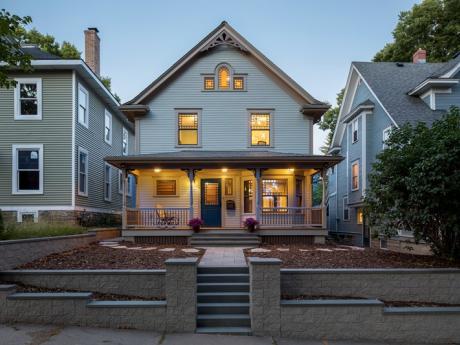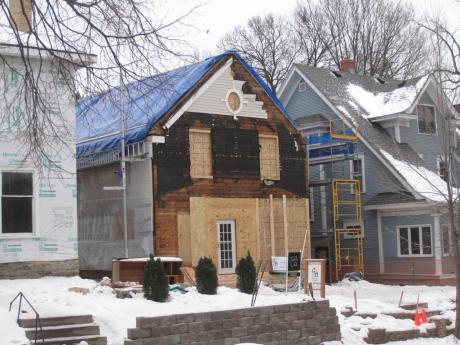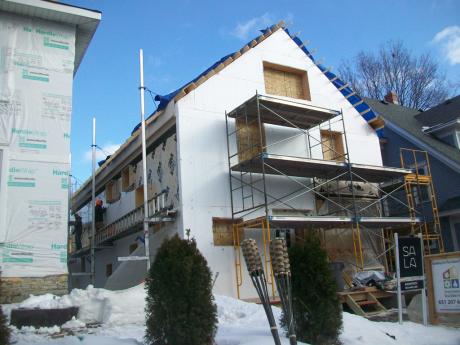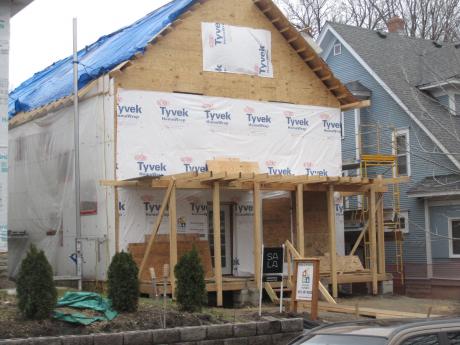Victorian net zero renovation
Project Photo Gallery
Project Team
Other Team Members
Marc Sloot, SALA Architects, Minneapolis.
Katie Leaf, SALA
Sean Morrissey, builder
Ratings, Awards and Recognition
Two retired professors, Linda and Stewart Herman, wanted to show that a standard city house on a standard city lot in chilly Minneapolis could be renovated to net zero in energy with no sacrifice in attractiveness, space or comfort. These goals were achieved with the 2015-2016 renovation of a 1907 balloon-frame house on a 40x130-foot lot in the Whittier neighborhood. Design was by SALA Architects of Minneapolis, MN; engineering by Align Structural of Minneapolis, and construction by Morrissey Builders of St. Paul, MN.
The four 'legs' of our net-positive house:
a. 54 solar collectors (42 on house, 12 on garage) for a 17kW capacity;
b. 4 250' deep geothermal wells in a 30 x 40 foot backyard;
c. Insulation: PERSIST exterior insulation system (R-40 in the walls, R-80 in the roof) and the Cocoon system for insulating the basement from exterior (R-30), and triple-glazed windows throughout.
d. Tight envelope: 3M ice-and-water plus extensive sealing around all openings keeps the infiltration rate to 350 at CFM50, or .05 CFM per square foot of building area shell surface. It exceeds code for tightness by five times.
To save energy, the house uses a geothermal heat pump, a heat-pump driven water heater, and a ventless heat-pump driven dryer. It is ventilated by an ERV (drawing exhaust air from kitchen and bathrooms). When the range hood operates, cooler makeup air is drawn past the refridgerator coils for more efficient cooling. The wallboard is of a new type (Certainteed 'Air-Renew') that absorbs formaldehyde for a promised ten years. All lighting is LED, whether in traditional fixtures, cans or other locations.
Attractiveness:
The interior of the total gut rehab involved a) retaining the original birch flooring (first floor) and installing recycled maple flooring harvested from three Twin Cities houses being demolished (2nd floor). The original yellow-birch millwork (window, door casings and baseboard) was refinished and reinstalled. Supplementary millwork is also regionally sourced yellow birch, milled in the same design as the original. For the comfort of the retired couple that lives there, the stairwell was widened to 4 feet and key doorways to 3 feet for wheelchair access. The bathrooms have rails, the cabinets have pull-outs, the drawers are soft-close.
'Aging in place': Since the owners are already in their later 60s, and hope to live in the house for as long as they are able, the house incorporates many design features from the National Association of Homebuilders to enable occupants to live in a house well into their old age: an easily rampable rear entry, on one level; 36" wide doorways to accommodate wheel chairs; wide turning places; a 4-foot wide stairway between floors; soft close cabinets in kitchen, base cabinets with pullout shelving; easily manipulable faucets; wall-mounted toilets (for easy cleaning); bright LED lighting throughout; sensor lighting on exterior; lever door handles on exterior doors; low-maintenance exteriors including porch decking; washing and drying machines raised 12" above floor; side-by-side refridgerator; laundry chute; grab bars in bathrooms including shower and tub; brightly-lit closets; etc.
Landscaping:
The yard is bordered by hardscape--Versalok blocks capped with NY Bluestone (also used for the front walk and terracing). 2500 square feet of the yard is planted in a variety of Minnesota perennials, mostly drought tolerant. A three-zone drip irrigation system is installed to carry these plantings through a dry summer. A much smaller slice of the yard is planted in Kentucky bluegrass, with no installed irrigation.
Quick Facts
General
| Location | Minneapolis, Minnesota |
|---|---|
| Building Type | single-family residence |
| Project Type | Net Exporter |
| Basis of Performance Claim | Modeled, Verified, Zero Energy Program |
| Bedrooms | 1 |
| Bathrooms | 3.0 |
| Conditioned Floor Area | 3,640 sq ft |
Energy Summary
| Energy Data Type | Modeled, Verified, Zero Energy Program |
|---|---|
| Renewable Energy System Type(s) | Photovoltaics, Geothermal |
| Ratings |
ILFI net zero (December 2017) |
| HERS Index | -9 |
| Net electricity usage (purchased) | 8,062 kWh/year |
| Annual renewable energy generated | 17,000 kWh/year |
Envelope and Mechanicals
| Subslab assembly |
Basement floor removed; new slab poured on top of 2" foam. |
|---|---|
| Foundation wall assembly |
Existing foundation variously reinforced concrete or stone. Little R value. |
| Above grade wall assembly |
joists extended to provide support for new exterior wall. See PERSIST description above |
| Door Assembly |
Andersen Windows & Doors. |
| Air Changes per hour, ACH50 | 350.00 ACH50 |





